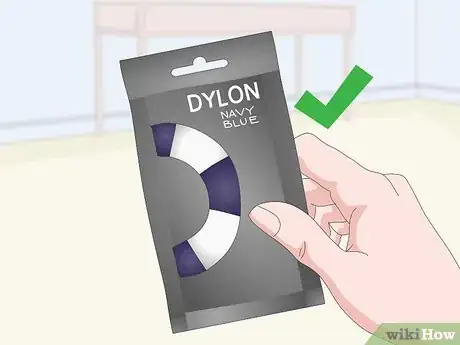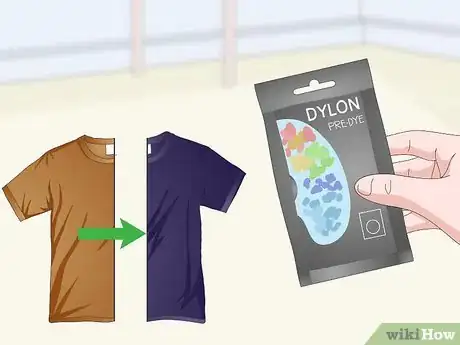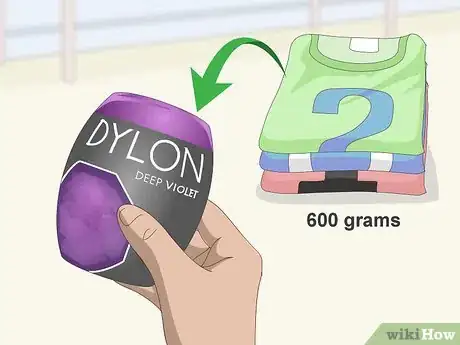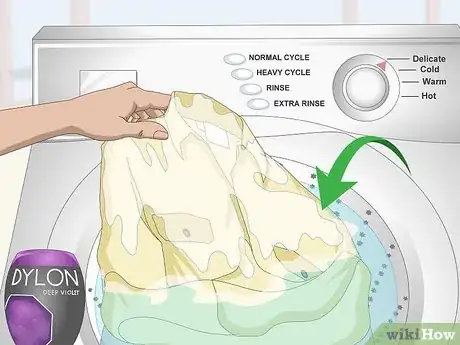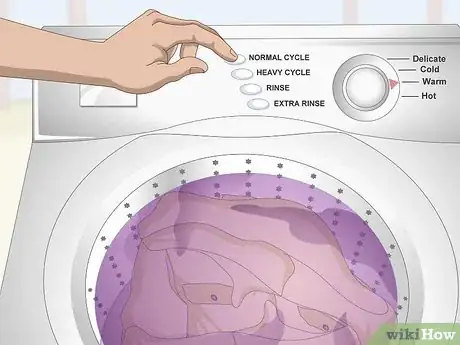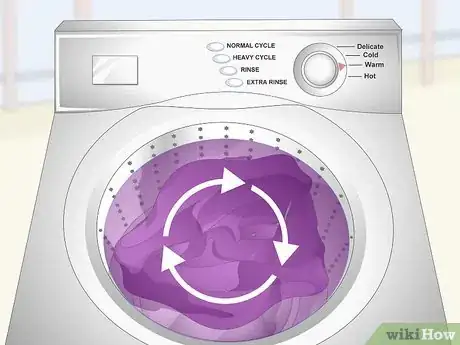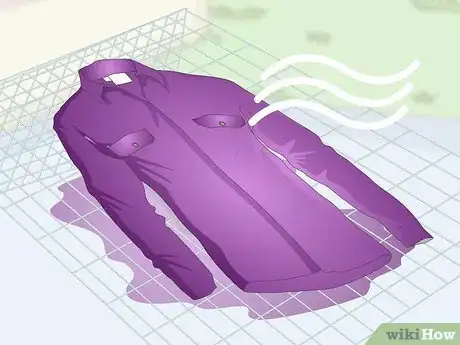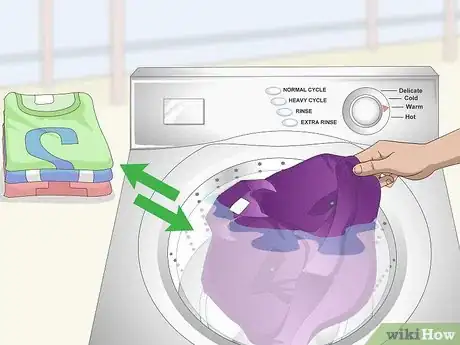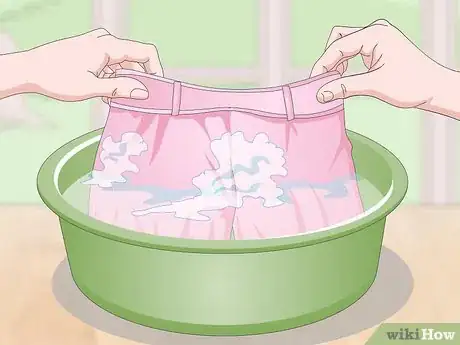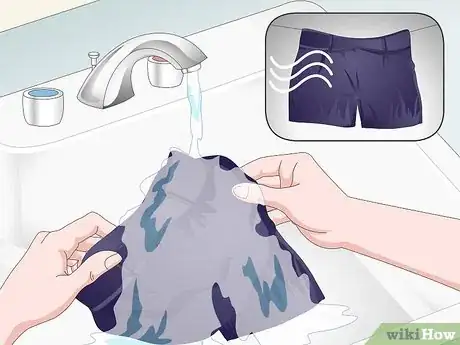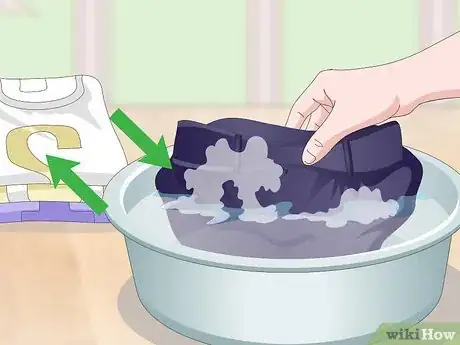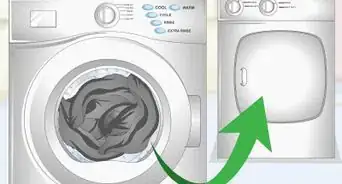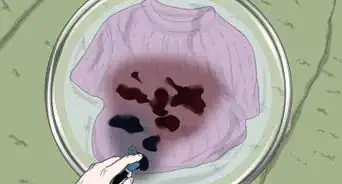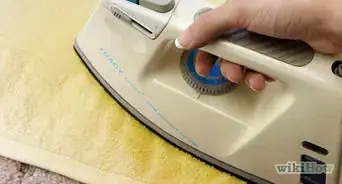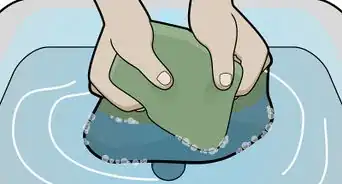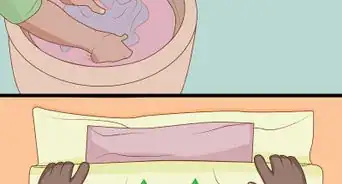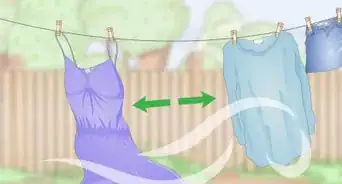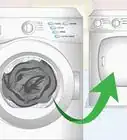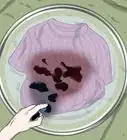This article was co-authored by wikiHow staff writer, Hunter Rising. Hunter Rising is a wikiHow Staff Writer based in Los Angeles. He has more than three years of experience writing for and working with wikiHow. Hunter holds a BFA in Entertainment Design from the University of Wisconsin - Stout and a Minor in English Writing.
This article has been viewed 41,154 times.
Learn more...
Dyeing your clothes is a way to get more use out of them if they are faded or if you just want a new look. Dylon fabric dyes are available in a wide range of colors and are easy to use at home. However, when dyeing fabrics containing polyester, you need to consider the ratio of polyester to natural fibers. You can dye larger items in a washing machine, while smaller items can be dyed by hand.
Steps
Determining If Your Fabric Can Be Dyed
-
1Make sure the fabric is no more than 50% synthetic. Dylon dye will not be effective on 100% polyester items, but blends of natural fibers and polyester can be dyed. Dylon recommends not dyeing any fabric that is made with more than 50 percent synthetic fibers.[1]
- Common natural fibers include cotton, linen, viscose, and denim.
- Common synthetic fibers include Gore-Tex, lycra, nylon, polyester, and spandex.
-
2Pick a darker-colored dye to achieve your desired shade. Since synthetic fibers will reject dye, only the natural fibers will be there to pick up the dye. The less natural fiber, the lighter and more diluted the shade.[2]
- Keep in mind that your dyed item will be lighter than the color displayed on the packet.
Advertisement -
3Remember that the fabric’s original color will affect the end result. For example, a yellow shirt dyed with blue dye will result in a green shade. Patterns may also be visible after you dye them. If you want your fabric to turn the color of your dye, make sure it’s white when you begin.[3]
- If your original item has bleach marks or stains, those areas may not be completely covered by the dye. If there’s bleach marks, you can try bleaching the entire item, but it will lose its original color.
-
4Use Dylon Pre-Dye to change fabric from one strong color to another. Pre-dye helps lighten dark fabrics so it’s easier to change their color. Pour the contents of the packet into your washing machine, add the items, and run the longest and hottest cycle. Then add laundry detergent and wash the item as usual.[4]
- Dylon Pre-Dye is meant to be used in washing machines and not by hand.
- Run your washing machine for 1-2 empty cycles after using the pre-dye so it doesn’t affect your other clothes.
Dyeing Large Items with Dylon Machine Dye
-
1Buy 1 machine dye pod for every 600 grams (21 oz) of fabric to be dyed. The items should be dry when you weigh them. If your clothes weigh more than 600 grams (21 oz), you should split them into two or more batches.[5]
-
2Wet the fabric before putting it and the dye pod in the washing machine. The items should be clean and damp so that they can accept the dye. Place the damp clothes in your washing machine and put an unwrapped and opened Dylon machine dye pod on top.[6]
- You can use the dye pod regardless of what type of washing machine you have.
-
3Use your washing machine’s regular wash cycle to dye your items. Set the machine to a full cycle with a water temperature of 40 °C (104 °F). Don’t use the economy or pre-wash options, because the water will not be the correct temperature or the cycle will be too long.[7]
- IF your washing machine doesn’t list exact temperatures, use the Warm cycle setting.
-
4Set the dye by running another cycle. This time, add laundry detergent to wash excess dye out of your items.[8] Use the same temperature water as you used for your other cycle. Once the cycle has finished, remove the items and run an empty cycle with laundry detergent to clean your machine.[9]
- If you don’t clean your washing machine, subsequent loads of laundry could become stained with excess dye.
-
5Dry the fabric on a drying rack. If you are air drying the fabric, keep it out of direct sunlight and make sure any folds have been shaken out. This will prevent fading or uneven spots of color.[10]
- After the first time, you can dry your items as you normally would.
-
6Wash the dyed items separate from your other laundry to keep them vibrant. For the first few washes, keep your dyed items separate from the rest of your laundry to prevent fading. Use cool or warm water during your cycle. Washing your dyed items separately will also protect your other clothing from being stained with excess dye.[11]
- You can iron your dyed items as you normally would.
Hand-Dyeing Smaller Items
-
1Wash your item thoroughly and leave it damp. The fabric needs to be clean so that it will accept the dye evenly. It needs to be wet for the dye to work.[12]
- Hand dyeing is best for small items like shorts, vests, or socks and for delicate items that you don’t want to put in the washing machine.
-
2Set up the dye bath with dye, water, and salt. Dissolve the entire package of dye in 500 millilitres (17 fl oz) of warm water. Fill a bowl or stainless steel sink with about 6 litres (6.3 US qt) of 40 °C (104 °F) water, stir in 250 grams (8.8 oz) of table salt, and then stir in the dye mixture.[13]
- Wear rubber gloves while mixing the dye since it could stain your skin.
- Some plastic and porcelain containers may get stained if you use dye in them.
-
3Submerge the fabric in the dye bath and stir for 60 minutes. Stir the fabric continuously for 15 minutes with your gloved hand, and then stir periodically for 45 minutes. This evenly distributes the dye into the fabric.[14]
- Instead of your hands, you can also use a stainless steel spoon for stirring your fabric.
-
4Rinse the fabric in cold water, hand wash, and air dry. You should keep rinsing until the water runs clear. Use warm water to wash the item. Dry the item on a drying rack away from direct heat and sunlight.[15]
-
5Wash your dyed fabric separately to avoid color bleed. The first few times you wash your item, hand wash it in warm water separate from other items to prevent fading. This will also keep other delicate items from becoming stained with any runoff dye.[16]
Warnings
- Run an empty load on your washing machine after using the dye so other laundry doesn’t get stained.⧼thumbs_response⧽
- Wash your dyed items 2-3 times separate from your other laundry to avoid any color bleed.⧼thumbs_response⧽
Things You’ll Need
Dyeing Large Items with Dylon Machine Dye
- Dylon Machine Dye pods
- Sink
- Washing machine
- Laundry detergent
- Drying rack
Hand-Dyeing Smaller Items
- Sink
- Dylon Hand Dye
- 500 millilitres (17 fl oz) of warm water
- 250 grams (8.8 oz) of table salt
- Drying rack
References
- ↑ https://www.dylon.co.uk/en/home/blog/which-fabrics-can-I-dye.html
- ↑ https://www.dylon.co.uk/en/home/blog/which-fabrics-can-I-dye.html
- ↑ https://www.dylon.co.uk/en/home/all-about-dylon/faq.html
- ↑ https://www.dylon.co.uk/en/home/products/pre-dye.html
- ↑ https://www.dylon.co.uk/en/home/blog/how-to-revive-your-faded-clothes-with-machine-dye.html
- ↑ https://www.dylon.co.uk/en/home/blog/how-to-revive-your-faded-clothes-with-machine-dye.html
- ↑ https://www.dylon.co.uk/en/home/blog/how-to-revive-your-faded-clothes-with-machine-dye.html
- ↑ https://www.dylon.co.uk/en/home/blog/how-to-revive-your-faded-clothes-with-machine-dye.html
- ↑ https://www.dylon.co.uk/en/home/blog/how-to-revive-your-faded-clothes-with-machine-dye.html
- ↑ https://www.sofeminine.co.uk/fashion-daily/dyeing-fabric-s563512.html
- ↑ https://www.dylon.co.uk/en/home/blog/which-fabrics-can-I-dye.html
- ↑ https://www.dylon.co.uk/en/home/products/hand-dye/yellow-and-red.html
- ↑ https://www.dylon.co.uk/en/home/products/hand-dye/yellow-and-red.html
- ↑ https://www.dylon.co.uk/en/home/products/hand-dye/yellow-and-red.html
- ↑ https://www.dylon.co.uk/en/home/products/hand-dye/yellow-and-red.html
- ↑ https://www.dylon.co.uk/en/home/blog/which-fabrics-can-I-dye.html

